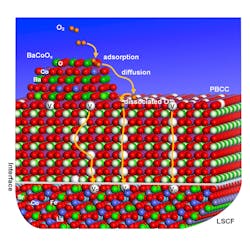Fuel cells have a major bottleneck in their processing that prevents them from making more electricity: The chemical processes involving oxygen are too slow. To make up for this bottleneck, engineers specify pure hydrogen fuel, which reacts with the oxygen taken in from the air. But the costs of producing the hydrogen have been prohibitive. A new catalyst is a potential game-changer, however.
“It easily converts chemical fuel into electricity with high efficiency,” says Meilin Liu, who led the study into the catalyst and is a Regents’ Professor in Georgia Tech’s School of Material Science and Engineering. “It lets you use readily available fuels such as methane and natural gas or makes hydrogen fuel much more efficiently.”
The catalyst manages this feat by rushing oxygen through a fuel cell. “It makes the reactions more than eight times as fast as state-of-the-art materials doing the same thing now,” says Yu Chen, a postdoctoral research associate in Liu’s lab.
There are several different types of fuel cells, but these researchers worked to improve solid oxide fuel cells, which are used in prototypical fuel cell cars. The research insights could also aid in improving supercapacitors paired with solar panels.
In combustion engines, fuel and oxygen from the air mix and are sparked to create an explosion, producing energy that turns a crankshaft. Adding a turbocharger speeds the process up by mixing the fuel and oxygen more quickly and rushing them to combustion.
The new fuel cell catalyst, a coating only about two dozen nanometers thick, works in two phases. First, nanoparticles on top grab molecular oxygen from the air and tear it into single oxygen ions. Then, oxygen vacancies in the nanoparticle rapidly pass the oxygen ions to the second phase, a layer of oxygen vacancies which move the ions quickly to meet with ionic hydrogen to complete the chemical process that powers fuel cells.
Currently, in fuel cells, hydrogen fuel and oxygen from the air also drive a process that produces energy—in this case, electricity. The two ingredients come together in a reaction, but one very different from combustion, and much cleaner.
One end of the fuel cell, the anode, removes electrons from the hydrogen atoms (oxidation) and sends them through an external circuit as electric current to the cathode on the other side. There, oxygen, which is notoriously electron-hungry, grabs the electrons (reduction), which keeps the electricity flowing. The hydrogen, now positively charged, and the oxygen, now negatively charged, meet up to form water, which is the fuel cell’s exhaust.
In that reaction chain, oxygen is the slow link for two reasons: Oxygen’s reduction takes longer than hydrogen’s oxidation, and reduced oxygen moves more slowly through the fuel cell to meet with hydrogen. Analogous to the turbocharger, the new catalyst pushes oxygen to go faster.
The catalyst is applied as a sheer coating (about two dozen nanometers thick) and is put the oxygen through two phases that break both oxygen bottlenecks.
First, nanoparticles highly attractive to oxygen grab the O2 molecule and let inflowing electrons quickly jump onto it, easily reducing it and tearing it into two separate oxygen ions (each one an O2-). Then a series of chemical gaps—oxygen vacancies that are built into the nanoparticles’ structures—suck up the oxygen ions and pass them on to the second phase of the catalyst.
The second phase is a coating full of oxygen vacancies that passes O2- even more rapidly toward its destination. So, oxygen goes down through the channels and enters the fuel cell, where it meets with ionized hydrogen or another electron donor like methane or natural gas.
The ions meet to make water, which exits the fuel cell. In the case of methane fuel, pure CO2 is also emitted, which can be captured and recycled back into fuel.
In the first stage, there are two different types of nanoparticle at work. Both have cobalt, but one contains barium and the other praseodymium, a rare-earth metal that can be pricey in high quantities.
“But such a small amount of praseodymium is needed that it doesn’t affect costs,” says Liu. “And the catalyst saves lots of money on fuel and other things.”
High operating temperatures in current fuel cells require expensive protective casings and cooling materials. The researchers believe the new catalyst could lower the temperatures by reducing electrical resistance inherent in current fuel cell chemistry. That could, in turn, potentially reduce overall material costs.
The second stage of the catalyst is a lattice containing praseodymium and barium, as well as calcium and cobalt (PBCC). In addition to its catalytic function, the PBCC coating prevents the cathode from degrading, which limits the lifetime of fuel cells and similar devices.
The underlying original cathode material, which contains the metals lanthanum, strontium, cobalt, and iron (LSCF), has become an industry standard, but comes with a caveat.
“It’s conductive and capable, but strontium is diminished in a process called segregation in the material,” Liu says. “One component of our catalyst, PBCC, acts as a coating and keeps the LSCF a lot more stable.”
LSCF manufacturing is already well-established, and adding the catalyst coating to production could reasonably be achieved. Liu also is considering replacing the LSCF cathode completely with the new catalyst material, and his lab is developing yet another catalyst to boost fuel oxidation reactions at the fuel cell’s anode.


